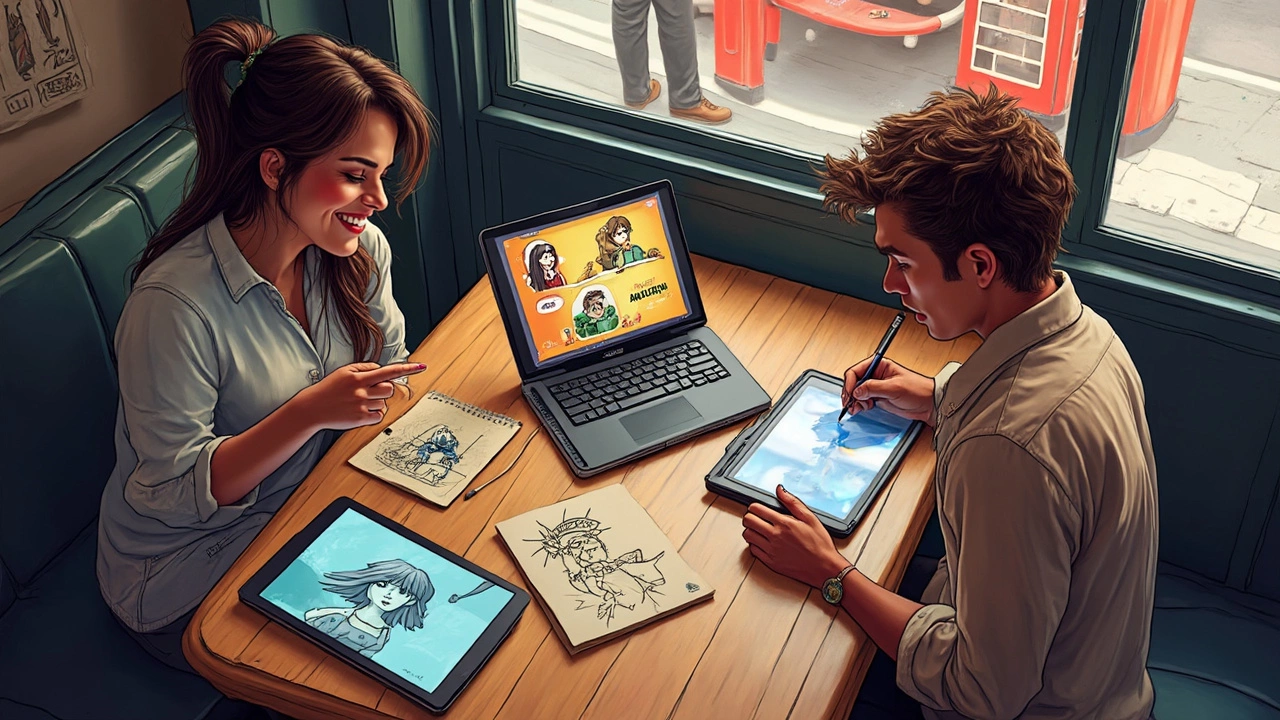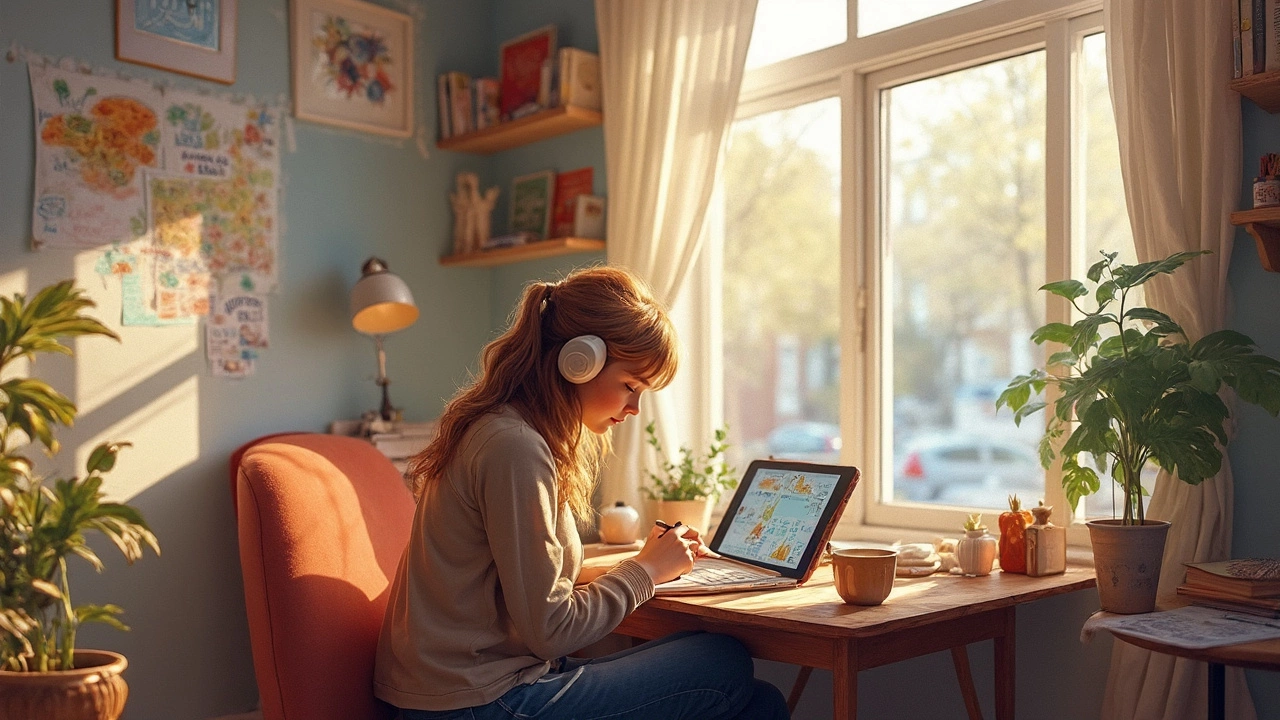Ever looked at a piece of digital art and thought, “Wish I could do that”? You really can, and it’s not just for people with expensive tools or fancy skills. If you’ve got a phone, tablet, or computer, you’re already halfway there. You don’t need to break the bank buying equipment on day one. Lots of amazing digital artists actually started doodling on their old smartphones, using free apps they found almost by accident.
The first question most people ask is, “What do I even need?” Honestly, you just need something you can draw on. This could be as simple as an iPad or even a laptop with a mouse. Sure, you’ll hear folks rave about drawing tablets, but if you’re just starting, try out what you already have before spending money. The key is to get comfortable drawing in a digital space—that feeling might take a few tries to click, but don’t stress if you feel wobbly at first. Everyone does.
- What You Need to Get Started
- Choosing the Right Software
- Learning the Basics & Finding Your Style
- Tips for Staying Motivated and Improving
What You Need to Get Started
What do you actually need to make your own digital art? Not as much as you might think. The main stuff comes down to three things: a device to draw on, a way to control your drawing (like a stylus, mouse, or your finger), and some kind of digital art software. That’s it. No gold-plated gadgets required.
Here’s a simple rundown of your options:
- Device: Most beginners use tablets (like iPad or Samsung Galaxy Tab), laptops, or even their phones. Some digital artists use desktop computers, but honestly, you’re fine with what’s handy.
- Stylus or Mouse: A stylus gives you better control, especially for detailed drawings, but you can start with a mouse or your finger if you’re just testing the waters.
- Software: Lots of solid free programs out there—Krita, MediBang, and Autodesk Sketchbook are known for being beginner-friendly. Procreate (for iPad) and Clip Studio Paint are killer paid options once you level up.
If you’re a numbers person, here’s a quick look at what digital artists out there are actually using:
| Device | Popular Brand/Model | Estimated User % (2024) |
|---|---|---|
| Tablet | iPad series | 46% |
| Laptop/PC | Windows & Mac laptops | 39% |
| Smartphone | iPhone, Android | 10% |
| Drawing Tablet (plugged into PC) | Wacom, Huion | 5% |
You might notice a lot of artists go for tablets, especially since the Apple Pencil works great for pressure-sensitive drawing. But don’t worry about keeping up; the right setup is the one that feels comfortable for you. Play around with a few free apps before investing in big gear. If you’re still unsure, ask other artists online what they like and why—it’s a super friendly community.
One last thing: Don’t forget comfort. Even a kitchen table makes a fine art studio, but a cheap wrist rest and getting your screen at eye level will help you avoid sore arms and headaches on longer drawing sessions. Happy experimenting!
Choosing the Right Software
This is where a lot of people get stuck, but honestly, picking art software doesn't have to be overwhelming. There’s no single “best” option. It really depends on what device you’re using and what feels easy for you. You can always switch later when you get more confident.
For a quick rundown, here are some solid options:
- Procreate: iPad only and costs around $13 (one-time). It’s the go-to for lots of artists because it’s easy to learn, powerful, and feels natural if you love sketching.
- Clip Studio Paint: Popular for both illustration and comics. It’s available on Windows, Mac, iPad, and Android. You can start with a free trial.
- Krita: Totally free, open source, and works best on Windows and Linux. It has loads of brushes and is perfect for painting and stylized art.
- Adobe Photoshop: Kind of an all-rounder, but it’s a monthly subscription (about $21/month). It’s packed with pro features, but it’s not cheap, and might be more than you need right now.
- Paint Tool SAI: Super simple, lightweight, and old-school. It runs on Windows, costs about $50, and lots of beginners swear by it.
Lately, a lot of people are creating awesome stuff with free apps they found in the App Store or Google Play. Don’t feel like you need to go big right away—some of the most popular digital illustrators on TikTok use free mobile apps. Here’s a comparison of the most used programs in 2024 so you can see what’s popular:
| Name | Platform | Cost | Best For |
|---|---|---|---|
| Procreate | iPad | $13 one-time | Sketching, painting |
| Krita | Windows/Linux/Mac | Free | Painting, illustrations |
| Clip Studio Paint | iPad/Android/PC/Mac | $0-89 (sales often) | Comics, illustration |
| Photoshop | PC/Mac/iPad | $21/month | Photo editing, advanced art |
| Paint Tool SAI | Windows | $50 | Simple drawing/painting |
If saving money is important right now, stick to free software like Krita—or even check out browser-based apps like Pixlr or Autodesk SketchBook. The best advice: download a few, mess around, and see what you like. You can always change it up later as you get used to the digital art process.

Learning the Basics & Finding Your Style
So you’ve picked the device and a drawing program—now what? Start by messing around with the brushes and tools. Most digital art apps, like Procreate, Krita, or Clip Studio Paint, have a bunch of brushes and effects you can use. Don’t feel like you need to know everything on day one. Try out basic brushes—pencil, ink, and paint—just to see how they feel. I found out I loved inking only after a week of random doodles.
If you’re totally new, check out free beginner tutorials on YouTube or TikTok. Some digital art courses, like the ones on Skillshare or Udemy, actually give month-long free trials, so you can learn the basics without paying right away. Most teach simple stuff, like sketching, shading, working with layers (which basically let you separate different parts of your art), and using shortcuts that save loads of time. Layers are huge—artists love them because you can edit bits of your picture without messing up the rest.
Finding your style comes with time. In the beginning, it’s normal to copy art you like (just don’t post it as your own). Try different looks—a cartoony drawing one day, something realistic the next. Save your old stuff and compare it after a few weeks. Even pro artists can spot their style changes in sketchbooks from a year ago.
- Copy a favorite artist’s piece for practice (private use only).
- Join online art challenges—like #DrawThisInYourStyle on Instagram—to push yourself to try new things.
- Keep your old work. Watching your progress is super motivating.
And please, don’t get hung up on mistakes. Even if your cat draws a better stick figure (Whiskers has honestly stepped on my tablet and made lines better than me sometimes), you’re still making progress. Have some fun, mess around, and soon your own vibe will start to show. That’s when the magic happens.
The more you experiment with digital art techniques and styles, the faster you’ll figure out what truly feels like “you.”
Tips for Staying Motivated and Improving
Burnout happens—especially when you hit a wall or don’t see fast progress. Lots of new artists think pros never mess up, but truth is, even seasoned folks get stuck. The trick is to make habits that help you show up and keep going, not just wait for some big wave of inspiration. Here’s what actually helps:
- Digital art challenges are your friend. A super popular one is “Draw This in Your Style.” You take someone’s art and draw it in your own way. This isn’t just fun, it pushes your brain to try new things and keeps your feed interesting too.
- Don’t try to learn everything at once. Pick one skill—like shading, coloring, or anatomy. Spend a week just practicing that. You’ll see faster improvement when you chunk things down, and you won’t get overwhelmed.
- Share your work, even if it’s rough. Post on Instagram, Twitter, or small art Discords. Most people are cheering you on way more than you think. Feedback (and a few likes) make a big difference on days you’re doubting yourself.
- Use reference photos. Seriously, nobody draws amazing hands from memory. Check out free sites like Unsplash or even snap a pic of your own hand. Tracing during practice isn’t cheating—it’s how your brain learns shapes.
- Set bite-sized goals. Instead of promising to draw an hour every day, start with ten minutes. Some days you’ll do more, some less, but even a tiny daily habit beats guilt from unrealistic goals.
If you ever start feeling bored, try learning a completely new tool in your art program or copying a style that’s way different from yours. Give yourself permission to make terrible art—you might even discover something cool by accident. Oh, and talk to other artists. That keeps it fun, which is really the point!

